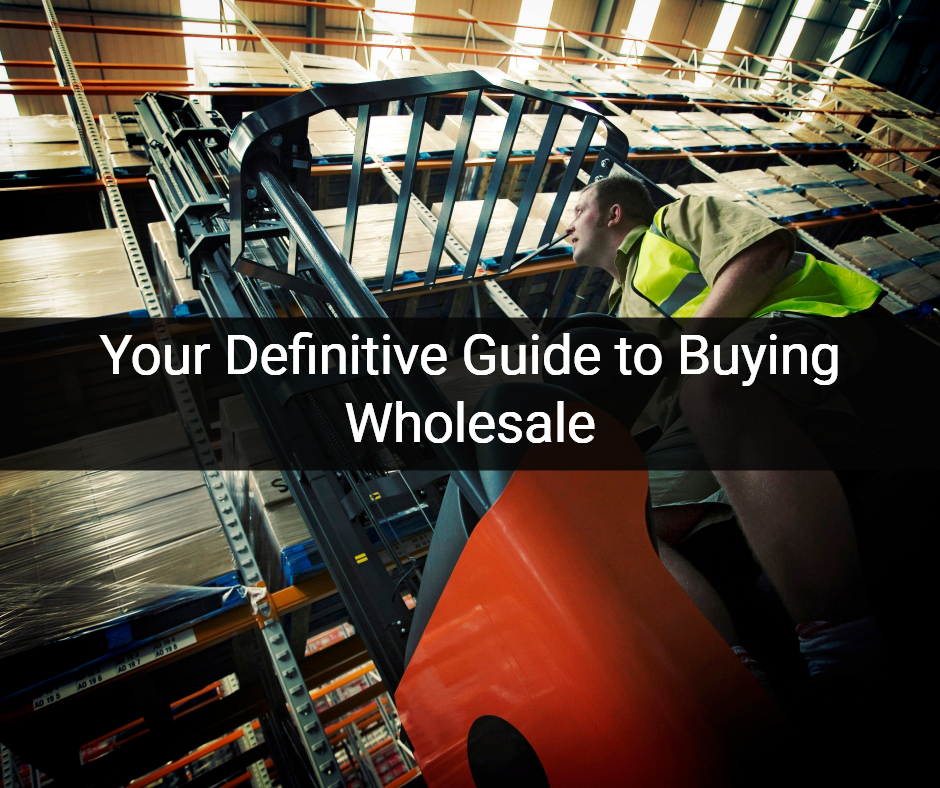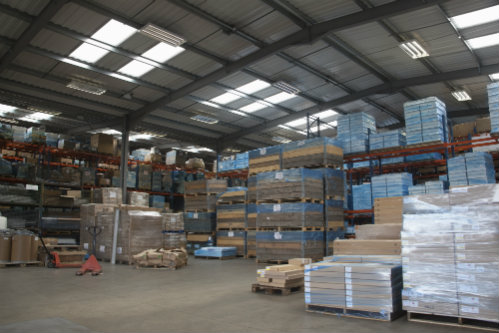Your Definitive Guide to Buying Wholesale
Posted by Shark Eyes on 27th Jun 2019

Purchasing plays a crucial part in running a retail business. You'll generally get the best deals when you buy wholesale. The process can be confusing and even overwhelming. It doesn't have to be though.
In this Definitive Guide to Buying Wholesale, you will learn how to get the most of your wholesale buying experience so you can focus on what's essential - making a profit.
Table of Contents:
Chapter 1 - What Wholesale Is and Isn't
Chapter 2 - Finding a Wholesaler That Fits Your Needs
Chapter 3 - Doing the Wholesale Math
Chapter 4 - Four Priceless Pricing Strategies
Chapter 5 - Making a Plan that Fits your Budget
Chapter 6 - Wholesale Networking
Chapter 7 - Working the Wholesale Puzzle
Chapter 1: What Wholesale Is and Isn't
Before you can master the art of buying wholesale, it's imperative to know what wholesale is and what it is not.
What is wholesale? Wholesale is purchasing in bulk to receive a discounted price.
That's generally the way it works, but it isn't always. You'll want to do the math to be sure you are receiving a lower price. Never assume buying more costs less.
Without mentioning any store or brand names, one of the most popular big box stores sells one of the most famous of all brands of coffee in two sizes, one is regular, and one is bulk. If you look at the breakdown of the price, you're paying more for the larger bulk item. The same can be true when purchasing multiple products. It's imperative to make sure you are getting a good deal, though.
You might be thinking that you are bypassing a go-between when you buy wholesale but, think again. A wholesaler is a middleman - between you and the manufacturer. Because you are buying in volume, saving the labor of getting the merchandise to a retail store and stocking the shelves with individual items or boxes, you get a good deal. The wholesaler benefits too.
He makes a profit off the goods you buy so you will want to make sure the price you pay wholesale is a good enough bargain that you can sell those products for a profit. The difference between the price wholesale and the retail price is called a margin. The amount of money you make over what you pay for the product is called the gross profit. Your gross profit is equal to the revenue minus the cost of goods sold, which is known as COGS.
Selling your products for a profit requires that the gross profit be enough that you can also pay your overhead like the rent or payments on your store (if you have a brick and mortar store), the cost of your advertising, utilities, and other incurred expenses. The price you sell your wares for also has to be competitive enough people will purchase them from you.
As a retailer, buying wholesale is your alternative to producing a product yourself. The price you pay for your wholesale items will ultimately determine how much you can mark it up and therefore, what your margin and your gross profit will be.

Chapter 2: Finding a Wholesaler that Fits Your Needs
Wholesale companies differ in many ways. Some offer full-service. You place an order, and they deliver it to your doorstep. These type of services usually come for a price. Many restaurants and grocery stores figure in the extra cost and find them worth paying since their orders are typically large and some require special handling like refrigeration in transit.
Many wholesalers deliver their goods by mail. Some wholesalers even offer free shipping when your order is a certain amount or over. Some companies require you to order through a, and then there are those that have an online site you can purchase. Wholesalers can operate out of stores you actually walk into and buy from or can be online.
You may prefer to do business with a wholesaler who assists you in your shopping needs, especially if what you order is ever-changing or complicated. Others opt to shop with minimal help at all.
Determining your personal and business needs and desires will help you figure out what wholesale supplier fits you best.
Another factor to consider is pricing. You may have a niche product that limits your choices in wholesalers, or you may find you have tons of options.
Customer service is something to think about as well. It is nice to be treated respectfully and to feel that a wholesaler values your business. If you have an issue or problem with your order, a helpful and friendly customer service department can be a lifesaver.

Chapter 3: Doing the Wholesale Math
As mentioned before, the price you sell your wares to your customers for must be consistent with the going rates in the market. If you price your merchandise too low, you won't make enough profit. If you sell too high, you may not have any customers. Especially with online shopping as an option, your customers do have choices, and therefore, you have competition.
You can create a more considerable margin and therefore, the potential for a better gross profit. You can shop around and find the wholesaler with the best price, of course. For example, we've supply wholesale reading glasses at rock bottom prices to convenience stores and missions all across the country.
You can also usually get an even deeper discount when you buy bulk in bulk. That is to say, when you purchase a higher quantity bulk order, you generally get a better deal. Although you may unable to afford the larger volume initially, you can set a goal to work up to it.
Chances are you'll also run into minimum order requirements. Wholesalers put those requirements in place to ensure they sell enough to make a profit themselves. The source you find to be the cheapest may require you to purchase more than you can afford. Again, you can set your sights to switching wholesalers once you build your buying power up.
If math isn't your thing, you'll need to find someone who can do your accounting for you. The math behind a retail business is something that you must do to make your business profitable. Many retail shops have accountants that help price items and tend to other needs as well, like tax preparation and payroll. You don't have to be a pro at math to run a retail business. But, if you're not, you'll need to hire someone who is.

Chapter 4: Four Priceless Pricing Strategies
Pricing is ultra-important for the success of your business. To set your business up to succeed, here are four winning strategies for wholesale pricing. Each has their positives and negatives, but one is likely to serve your needs better than the rest.
Competitive Pricing. This method is common. You figure out what the average price your product is going for and sell it accordingly, perhaps even a little bit lower. It requires research to find out the average price range of an item. But, it's well worth the effort if this is the strategy that best fits your style.
Absorption Pricing. If you are a practical thinker, you'll love this strategy. It takes into consideration all the factors, like all costs entailed in buying the product, running the store, advertising, etc. Once you add in everything, you'll be able to set the price. Keeping accurate records of costs incurred will be vital in making this strategy work for you.
Demand Pricing. This pricing strategy is all about supply and demand. If you are the only one, or one of the only ones, who carries a particular product, you can generally get by with pricing the item higher as long as it is something people need or want, and the demand is high enough. Supply and demand is something that you want to research before planning your pricing accordingly.
Geographical Pricing. If you live in a remote, mountainous area, you'll be able to charge more for your goods, as a rule. Chances are you won't have a lot of competition, locally, at least. The downside is online shopping is very competitive and is readily available to most everyone these days.
Of course, there are other pricing strategies. Some price their goods for a "going out of business" sale. Others take a loss to run a deal on one product to lure customers in to buy other items at regular price. Aside from extenuating circumstances, though, one of the four basic price strategies will most likely be a good fit for you.

Chapter 5: Making a Plan that Fits your Budget
Shopping wholesale is much like shopping retail when it comes to the temptation to overspend. It's easy to walk out with much more than you need or can afford. Having a dedicated plan before you go is wise. It's easy to get sidetracked or overwhelmed during the process.
Have your list and stick to it. Writing your list on paper or the note section of your smartphone is very helpful. Be sure your spending budget pre-planned too. Sometimes, being mindful of the price range you are committed to sticking with may involve some negotiating with the wholesaler when possible if the price turns out to be higher.
Other times, you may have to budge a bit to get your product at all. If that's the case, you'll need to refigure the price you'll charge as well, or it will cut into your profit. Sometimes, you'll have to take the loss and pay a little more yet sell for the set price and make less. It all depends on your product and the market.
You'll also want to do your homework on the value of the product you wish to purchase. Have a decisive price point based upon your knowledge and research and refuse to go over it unless it is imperative.
Do the same for things you'll need other than merchandise such as your displays, signs, and counter racks. Check for the best prices on the extras you need and also see if any of the wholesalers you are considering have perks like including display cases with an order. Some wholesalers have pre-tagged items which save you both time and money. Others offer hangers with their clothing or include gift boxes with their products. Little things indeed add up.

Chapter 6: Wholesale Networking
Don't be afraid to do a little wheeling and dealing with your wholesaler. Maybe you have a retail sports shop. Just because he sells sporting goods among his many other wholesale wares doesn't mean he has any sporting goods. Perhaps you can accommodate him with something he'd like from your store for a better price in his store.
When you are socializing with other retailers, ask what wholesale company or companies they use. Word of mouth is often the best way to find great wholesalers.
If you bring in business to a wholesaler, be sure to mention it and have your referral state that too. Ask for a discount or some reward for bringing in a new customer. Who knows, you might get what you requested.
When asking for referrals on good wholesalers, keep your ears peeled for less than positive reports on them too. You may find out that the China wholesaler you are about to send your credit card information to is not legitimate at all or that an international wholesale company takes lightyears to deliver.
Wholesale networking can involve a plethora of scenarios. Mostly it entails communicating with other retailers and wholesalers too to get feedback, stir up negotiations, and to broaden your opportunities.

Photo by Hans-Peter Gauster on Unsplash
Chapter 7: Working the Wholesale Puzzle
Wholesale is one of the most vital components of retail. Your wholesale products are the lifeline to your business. The price you pay for those products can also breathe life or death into your company. Furthermore, having an excellent wholesaler who has your best interest at heart can play a crucial role in your company's success.
Take Linda, Joe, Jerry, and Janine, for instance. Each of the four had an excellent idea for a retail store. They couldn't wait to get their businesses rolling. They all had one thing in common - passion for retail. The ways they went about their wholesale planning (or lack of planning) differed significantly though.
Linda was an academic person. She spent hours researching her product line on the computer and narrowed down the best place to get her wares. Linda factored in all the business costs, like rent on the building, utilities, and even the hangers the clothing line hung on. Then she came up with a price for her merchandise, also making sure it was along the same price lines as other similar retailers in the area and online as well.
Joe was sure his product would sell. It was unique. No one else in his remote area sold such an item. He found a reasonable price and ordered tons. He forgot, however, about two essential things. He didn't check to be sure the demand was there. It appeared that no one wanted his item because no one was buying them - or so he thought. As it turned out, there were at least some people who wished to purchase the unique item. But, they were already buying it online.
Jerry was ecstatic the day he found a particular wholesale warehouse that carried his retail product for way less than he was currently paying. Jerry dashed into the store and bought a pallet of them. The problem was that although Jerry had the money to pay for his products, he'd forgotten all about the rent that was due for his store. He lost his lease and was stuck with a slew of products.
Janine had already purchased her wholesale products by the time she opened her store. She knew the store down the street sold the same thing but counted on her friendly customer service and fancy building to draw customers. When Janine began to figure the price of her elegant building, however, it was necessary for her to raise her rate to compensate for the lease. It didn't take long for savvy shoppers to know she was charging more than her competitor. They felt insulted, and soon, no one came to buy her products.
The four stories are very similar to many real-life retailers. It is beneficial to fit all the pieces of the wholesale puzzle together to make wholesale buying work for you and not against you. When you learn to do that, you'll have a wholesale game plan that's a sure winner.
Conclusion
That's it for Your Definitive Guide to Buying Wholesale. Do you think you're ready to try it out so you can get your retail business working for you?
